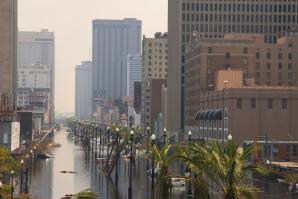The last sound anyone wants to hear is a firetruck siren. But last fall, that unsettling sound rang in the middle of the night as a three-alarm fire leaped from an apartment building in midtown Sacramento to the roof of J Street Recorders, home of the multiplatinum blues metal band Tesla.
No one was injured in the fire, and the studio, built in 2003, had separate isolation booths soundproofed with Sheetrock. Its layered structure could keep the lower rooms safe from the flames — but not the water. As firefighters blasted the raging blaze with hoses, water flooded the studio, raining down on expensive recording gear and instruments.
“We didn’t lose any of the floors until the water came in,” says Marko Bustos, a guitar tech, who built the studio with Tesla bassist Brian Wheat. “That kind of gear doesn’t hold too well to water. I can imagine it was well over [$1 million] in damages to the equipment.”
It was a total loss for Wheat, who owns the studio. In the aftermath, he realizes that when it comes to insurance policies, it’s always better to play it safe or you’ll be sorry. “He said he’s well-underinsured,” Bustos says. “This is what I hear him tell people: ‘Even though you think you’re never going to have a fire, it doesn’t matter. Make sure you up your policy because if you think you have enough to cover something, you don’t.’”
It’s the scenario no business owner wants to face. But in the Capital Region, where fires, floods and earthquakes can strike at any time, employers can’t afford to operate without plans for minimizing losses and getting the business running again as soon as possible.
“In California, we have many [risks], so business continuity is very important,” says Tina Curry, assistant secretary for Planning, Protection and Preparedness at the California Emergency Management Agency. “At a basic level, all of us have a responsibility to be prepared in our homes and businesses as well. That will make large-scale response easier if we know the population has done stuff ahead of time to keep themselves safe.”
The state uses the Standardized Emergency Management System to coordinate emergency response efforts across California. But Curry says an effective response comes through private and public partnerships: Businesses need to have emergency plans in place so first responders can focus on the most urgent needs. Unfortunately, the lack of a sound policy and a backup plan forces many businesses to go belly up. At least one-fourth of all businesses that close because of a disaster never reopen, according to the Institute for Business and Home Safety.
Given the fact that businesses that know how to assess risks and implement mitigation and recovery plans tend to have less damage, loss and downtime, a disaster preparedness plan is critical — especially in a time when the economy is equally unpredictable.
“With shrinking budgets that everyone’s facing, we’ve done a lot to reach out and partner with the private sector,” Curry says. “We write plans for emergencies, but we’re also very dependent on one another because disaster will strike with no notice.”
Collaboration is one of the main ideas behind a state-of-the-art training center coming soon to Rancho Cordova. Spearheaded by Larry Davis, the chief administrative officer for Sacramento Metro Fire District, this center will sit on 50 acres just off the former Mather Air Force Base as a training hub for various disciplines, from police and fire to public works and social services. The training center will also provide community college and vocational courses for credit granted by Sacramento State. Right now, the facility is in its early stages as parties sort out financing.
“The federal government expects us to be prepared for a terrorist event,” he says. “One of the things terrorists want to do is upset our economy. The quicker we can get businesses back up and running and respond to the terrorist event, the more we can minimize any economic impact.”
On Oct. 21, 2010, the Westfield Galleria at Roseville felt the burn of disruption when an arsonist reportedly set fire to the mall. Firefighters and police converged on the scene to extinguish the inferno and catch the culprit. Firefighters from nearby communities were called for support as public safety officials evacuated the mall. Nobody was hurt, but the fire destroyed some 20 stores, caused around $55 million in damage and gave the business community a harsh reality check about disaster preparedness.
“Could they relocate? Could they get new supplies? Were they insured?” says Rick Martinez, chief of emergency services with the Sacramento City and County Office of Emergency Services. “If you’re a business that has not been damaged severely, can you get workers into the business? Are there utilities? If you have a business that requires cold storage and there’s no electricity, do you have a backup generator?”
These types of questions should be thought through beforehand so businesses can respond — rather than react — to an incident. Each business has different needs, so business continuity plans will vary. The mall, itself, also has elements that other businesses might not have to consider. For example, with the stores connected, owners may not know the activities of their neighbors, which might put them in a vulnerable position. At the same time, Martinez says, big facilities have a number of systems built in and get regular inspections.
A week after the incident, city officials opened about 40 stores in the undamaged sections of the mall. But other stores in the “red zone,” the heavily damaged and structurally unsound area, remained closed. Women’s apparel retailer, bebe, was one of them. After nine years in the Galleria, the store was demolished. To prevent black marketing theft and duplication, store owners had all the merchandise shredded on site.
“We would never want our merchandise to appear on eBay,” says Helyn Hoffman, risk manager for bebe Stores Inc. “Literally, I was watching thousands of dollars of boots and jackets and things become little pieces.”
Pinnacle Emergency Management handled the recovery efforts, including the shredding, and provided a sense of security throughout the process, which Hoffman says made a huge difference in addition to the store’s accurate inventory and detailed to-do lists. But early on, Hoffman struggled with lapses in communication regarding the status of the store. “My store was sealed shut for 40 days,” she says. “In the red zone, we weren’t allowed to go into the area and we weren’t given clear immediate direction.”
At this point, she’s still putting numbers together to determine business continuity losses. In terms of rebuilding, she estimates the store will be back in business sometime in the fall.
This past December, representatives from the Department of Homeland Security, emergency response agencies and the business community gathered at Sacramento State to discuss policies and methods for disaster preparedness. They discussed standard business strategies such as an emergency checklist, supplies and the importance of open communication. But one other key message kept coming up: In the event of a large-scale disaster, have employees made preparations at home? If not, business continuity may suffer.
“If people are worried about loved ones, they really can’t be valuable to keep the company going,” says Jenni Murphy, senior director of strategic communications and emerging markets in Sacramento State’s College of Continuing Education. “If they haven’t prepared themselves with their family, they’re no good to you.”
Pinnacle, which provides restoration services in Northern California, Northern Nevada and the greater Houston region, hosts education workshops for companies on how the claims process works and other disaster preparedness tactics specific to that business. The door in the company’s West Sacramento conference room leads to a 30,000-square-foot warehouse filled with giant wooden boxes and plastic bags.
“Most companies end up reacting after the disaster,” says Leo Grover, the company’s president. “They always say ‘We’ve never been through this. We didn’t expect it.’ You just have to ask a lot of what-if questions.”
In the back corner of the warehouse lie artifacts from Tesla’s studio: speakers, drums, a barrel of sleeping bags, guitars, worn chairs, keyboards, an assortment of microphones, a punching bag. No one knows how soon the studio will be operational again. The only other studios with the same functionality are in Los Angeles and New York, Bustos says. But the tragedy isn’t stopping the movement. On Jan. 6, the band posted a note on its website, titled “Tesla is in the Studio!”
“Jeff Keith and Frank Hannon have been working in the studio recording some tracks for the acoustic-style album that TESLA has been planning to release for the 20th anniversary of their multiplatinum 5 MAN ACOUSTIC JAM album,” the update reads. “There is no tentative title for the NEW release yet, but expect to hear some never before heard versions of TESLA classics such as ‘Changes’, ‘Paradise’, as well as some recordings of studio versions from the 2004 acoustic tour. Also featured will be a brand new song called “2nd Street”, and the infamous “Better off without You” recorded acoustically. Stay Tuned for more….”
Recommended For You

Fire Drill
A proactive approach to managing fire systems could save you thousands
The walls are freshly painted. Fashionable new light fixtures hang from the ceiling. It’s got the right zip code, the right floor plan, the right price. Think you’re ready to buy that commercial property? Unless you have peered behind those walls and assessed all that’s happening above those lights, fire protection experts say you shouldn’t sign on the dotted line.

Waterborne Disorder
In the event of flood, area hospitals are at risk
In the hours before Hurricane Sandy hit New York last year, the country’s oldest public hospital thought it was ready.



